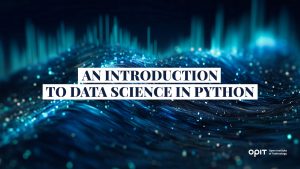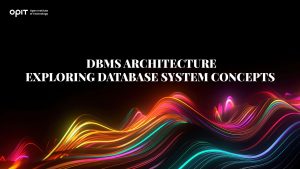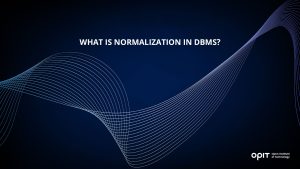
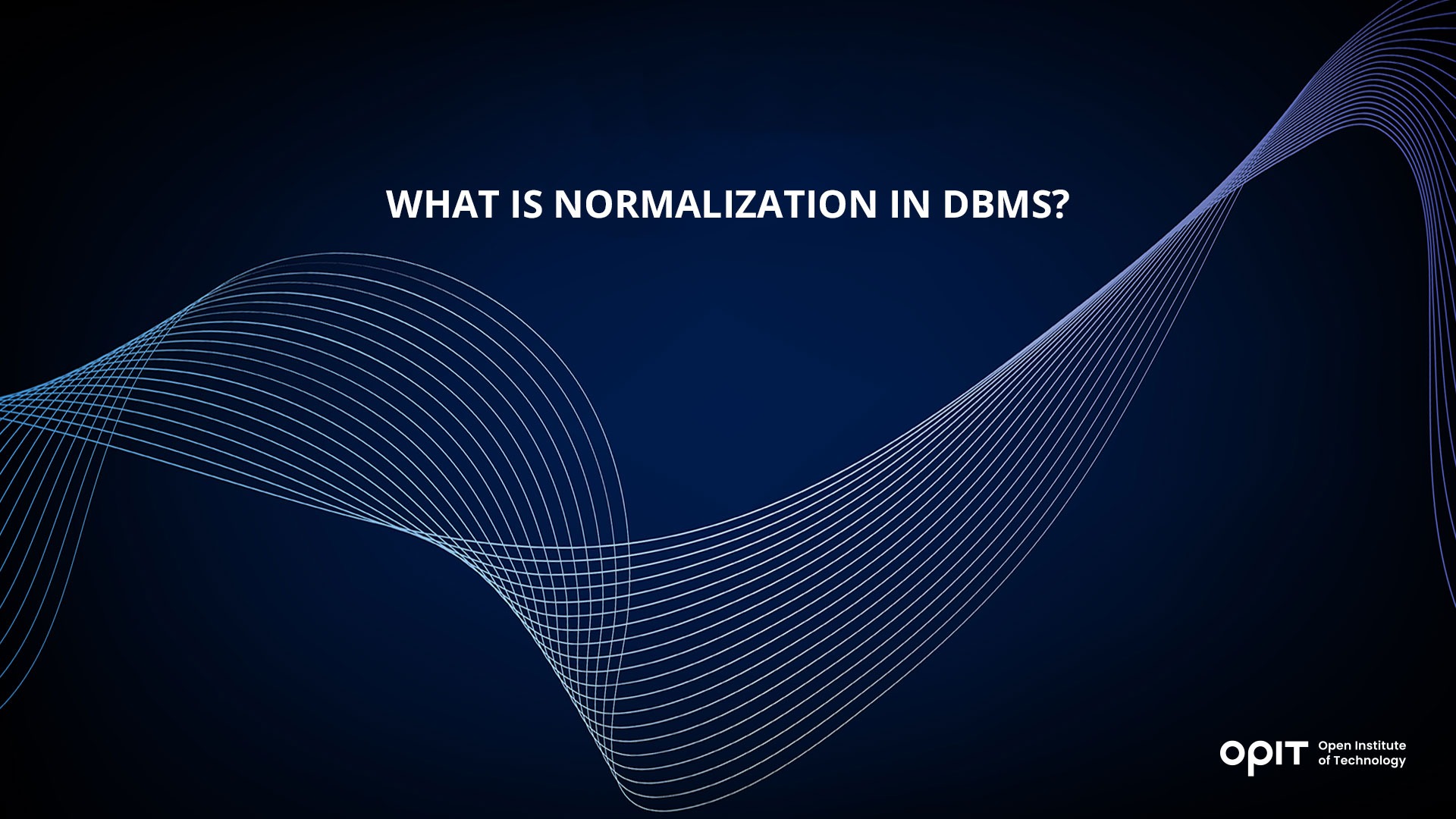
The larger your database, the higher the possibility of data repetition and inaccuracies that compromise the results you pull from the database. Normalization in DBMS exists to counteract those problems by helping you to create more uniform databases in which redundancies are less likely to occur.
Mastering normalization is a key skill in DBMS for the simple fact that an error-strewn database is of no use to an organization. For example, a retailer that has to deal with a database that has multiple entries for phone numbers and email addresses is a retailer that can’t see as effectively as one that has a simple route to the customer. Let’s look at normalization in DBMS and how it helps you to create a more organized database.
The Concept of Normalization
Grab a pack of playing cards and throw them onto the floor. Now, pick up the “Jack of Hearts.” It’s a tough task because the cards are strewn all over the place. Some are facing down and there’s no rhyme, reason, or pattern to how the cards lie, meaning you’re going to have to check every card individually to find the one you want.
That little experiment shows you how critical organization is, even with a small set of “data.” It also highlights the importance of normalization in DBMS. Through normalization, you implement organizational controls using a set of principles designed to achieve the following:
- Eliminate redundancy – Lower (or eliminate) occurrences of data repeating across different tables, or inside individual tables, in your DBMS.
- Minimize data anomalies – Better organization makes it easier to spot datasets that don’t fit the “norm,” meaning fewer anomalies.
- Improve data integrity – More accurate data comes from normalization controls. Database users can feel more confident in their results because they know that the controls ensure integrity.
The Process of Normalization
If normalization in DBMS is all about organization, it stands to reason that they would be a set process to follow when normalizing your tables and database:
- Decompose your tables – Break every table down into its various parts, which may lead to you creating several tables out of one. Through decomposition, you separate different datasets, eliminate inconsistencies, and set the stage for creating relationships and dependencies between tables.
- Identify functional dependencies – An attribute in one table may be dependent on another to exist. For example, a “Customer ID” number in a retailer’s “Customer” table is functionally dependent on the “Customer Name” field because the ID can’t exist without the customer. Identifying these types of dependencies ensures you don’t end up with empty records (such as a record with a “Customer ID” and no customer attached to it).
- Apply normalization rules – Once you’re broken down your table and identified the functional dependencies, you apply relevant normalization rules. You’ll use Normal Forms to do this, with the six highlighted below each having its own rules, structures, and use cases.
Normal Forms in DBMS
There isn’t a “single” way to achieve normalization in DBMS because every database (and the tables it contains) is different. Instead, there are six normal forms you may use, with each having its own rules that you need to understand to figure out which to apply.
First Normal Form (1NF)
If a relation can’t contain multiple values, it’s in 1NF. In other words, each attribute in the table can only contain a single (called “atomic”) value.
Example
If a retailer wants to store the details of its customers, it may have attributes in its table like “Customer Name,” “Phone Number,” and “Email Address.” By applying 1NF to this table, you ensure that the attributes that could contain multiple entries (“Phone Number” and “Email Address”) only contain one, making contacting that customer much simpler.
Second Normal Form (2NF)
A table that’s in 2NF is in 1NF, with the additional condition that none of its non-prime attributes depend on a subset of candidate keys within the table.
Example
Let’s say an employer wants to create a table that contains information about an employee, the skills they have, and their age. An employee may have multiple skills, leading to multiple records for the same employee in the table, with each denoting a skill while the ID number and age of the employee repeat for each record.
In this table, you’ve achieved 1NF because each attribute has an atomic value. However, the employee’s age is dependent on the employee ID number. To achieve 2NF, you’d break this table down into two tables. The first will contain the employee’s ID number and age, with that ID number linking to a second table that lists each of the skills associated with the employee.
Third Normal Form (3NF)
In 3NF, the table you have must already be in 2NF form, with the added rule of removing the transitive functional dependency of the non-prime attribute of any super key. Transitive functional dependency occurs if the dependency is the result of a pair of functional dependencies. For example, the relationship between A and C is a transitive dependency if A depends on B, B depends on C, but B doesn’t depend on A.
Example
Let’s say a school creates a “Students” table with the following attributes:
- Student ID
- Name
- Zip Code
- State
- City
- District
In this case, the “State,” “District,” and “City” attributes all depend on the “Zip Code” attribute. That “Zip” attribute depends on the “Student ID” attribute, making “State,” “District,” and “City” all transitively depending on “Student ID.”
To resolve this problem, you’d create a pair of tables – “Student” and “Student Zip.” The “Student” table contains the “Student ID,” “Name,” and “Zip Code” attributes, with that “Zip Code” attribute being the primary key of a “Student Zip” table that contains the rest of the attributes and links to the “Student” table.
Boyce-Codd Normal Form (BCNF)
Often referred to as 3.5NF, BCNF is a stricter version of 3NF. So, this normalization in DBMS rule occurs if your table is in 3NF, and for every functional dependence between two fields (i.e., A -> B), A is the super key of your table.
Example
Sticking with the school example, every student in a school has multiple classes. The school has a table with the following fields:
- Student ID
- Nationality
- Class
- Class Type
- Number of Students in Class
You have several functional dependencies here:
- Student ID -> Nationality
- Class -> Number of Students in Class, Class Type
As a result, both the “Student ID” and “Class” attributes are candidate keys but can’t serve as keys alone. To achieve BCNF normalization, you’d break the above table into three – “Student Nationality,” “Student Class,” and “Class Mapping,” allowing “Student ID” and “Class” to serve as primary keys in their own tables.
Fourth Normal Form (4NF)
In 4NF, the database must meet the requirements of BCNF, in addition to containing no more than a single multivalued dependency. It’s often used in academic circles, as there’s little use for 4NF elsewhere.
Example
Let’s say a college has a table containing the following fields:
- College Course
- Lecturer
- Recommended Book
Each of these attributes is independent of the others, meaning each can change without affecting the others. For example, the college could change the lecturer of a course without altering the recommended reading or the course’s name. As such, the existence of the course depends on both the “Lecturer” and “Recommended Book” attributes, creating a multivalued dependency. If a DBMS has more than one of these types of dependencies, it’s a candidate for 4NF normalization.
Fifth Normal Form (5NF)
If your table is in 4NF, has no join dependencies, and all joining is lossless, it’s in 5NF. Think of this as the final form when it comes to normalization in DBMS, as you’ve broken your table down so much that you’ve made redundancy impossible.
Example
A college may have a table that tells them which lecturers teach certain subjects during which semesters, creating the following attributes:
- Subject
- Lecturer Name
- Semester
Let’s say one of the lecturers teaches both “Physics” and “Math” for “Semester 1,” but doesn’t teach “Math” for Semester 2. That means you need to combine all of the fields in this table to get an accurate dataset, leading to redundancy. Add a third semester to the mix, especially if that semester has no defined courses or lecturers, and you have to join dependencies.
The 5NF solution is to break this table down into three tables:
- Table 1 – Contains the “Semester” and “Subject” attributes to show which subjects are taught in each semester.
- Table 2 – Contains the “Subject” and “Lecturer Name” attributes to show which lecturers teach a subject.
- Table 3 – Contains the “Semester” and “Lecturer Name” attributes so you can see which lecturers teach during which semesters.
Benefits of Normalization in DBMS
With normalization in DBMS being so much work, you need to know the following benefits to show that it’s worth your effort:
- Improved database efficiency
- Better data consistency
- Easier database maintenance
- Simpler query processing
- Better access controls, resulting in superior security
Limitations and Trade-Offs of Normalization
Normalization in DBMS does have some drawbacks, though these are trade-offs that you accept for the above benefits:
- The larger your database gets, the more demands it places on system performance.
- Breaking tables down leads to complexity.
- You have to find a balance between normalization and denormalization to ensure your tables make sense.
Practical Tips for Mastering Normalization Techniques
Getting normalization in DBMS is hard, especially when you start feeling like you’re dividing tables into so many small tables that you’re losing track of the database. These tips help you apply normalization correctly:
- Understand the database requirements – Your database exists for you to extract data from it, so knowing what you’ll need to extract indicates whether you need to normalize tables or not.
- Document all functional dependencies – Every functional dependence that exists in your database makes the table in which it exists a candidate for normalization. Identify each dependency and document it so you know whether you need to break the table down.
- Use software and tools – You’re not alone when poring through your database. There are plenty of tools available that help you to identify functional dependencies. Many make normalization suggestions, with some even being able to carry out those suggestions for you.
- Review and refine – Every database evolves alongside its users, so continued refining is needed to identify new functional dependencies (and opportunities for normalization).
- Collaborate with other professionals – A different set of eyes on a database may reveal dependencies and normalization opportunities that you don’t see.
Make Normalization Your New Norm
Normalization may seem needlessly complex, but it serves the crucial role of making the data you extract from your database more refined, accurate, and free of repetition. Mastering normalization in DBMS puts you in the perfect position to create the complex databases many organizations need in a Big Data world. Experiment with the different “normal forms” described in this article as each application of the techniques (even for simple tables) helps you get to grips with normalization.
Related posts

Source:
- Raconteur, published on November 06th, 2025
Many firms have conducted successful Artificial Intelligence (AI) pilot projects, but scaling them across departments and workflows remains a challenge. Inference costs, data silos, talent gaps and poor alignment with business strategy are just some of the issues that leave organisations trapped in pilot purgatory. This inability to scale successful experiments means AI’s potential for improving enterprise efficiency, decision-making and innovation isn’t fully realised. So what’s the solution?
Although it’s not a magic bullet, an AI operating model is really the foundation for scaling pilot projects up to enterprise-wide deployments. Essentially it’s a structured framework that defines how the organisation develops, deploys and governs AI. By bringing together infrastructure, data, people, and governance in a flexible and secure way, it ensures that AI delivers value at scale while remaining ethical and compliant.
“A successful AI proof-of-concept is like building a single race car that can go fast,” says Professor Yu Xiong, chair of business analytics at the UK-based Surrey Business School. “An efficient AI technology operations model, however, is the entire system – the processes, tools, and team structures – for continuously manufacturing, maintaining, and safely operating an entire fleet of cars.”
But while the importance of this framework is clear, how should enterprises establish and embed it?
“It begins with a clear strategy that defines objectives, desired outcomes, and measurable success criteria, such as model performance, bias detection, and regulatory compliance metrics,” says Professor Azadeh Haratiannezhadi, co-founder of generative AI company Taktify and professor of generative AI in cybersecurity at OPIT – the Open Institute of Technology.
Platforms, tools and MLOps pipelines that enable models to be deployed, monitored and scaled in a safe and efficient way are also essential in practical terms.
“Tools and infrastructure must also be selected with transparency, cost, and governance in mind,” says Efrain Ruh, continental chief technology officer for Europe at Digitate. “Crucially, organisations need to continuously monitor the evolving AI landscape and adapt their models to new capabilities and market offerings.”
An open approach
The most effective AI operating models are also founded on openness, interoperability and modularity. Open source platforms and tools provide greater control over data, deployment environments and costs, for example. These characteristics can help enterprises to avoid vendor lock-in, successfully align AI to business culture and values, and embed it safely into cross-department workflows.
“Modularity and platformisation…avoids building isolated ‘silos’ for each project,” explains professor Xiong. “Instead, it provides a shared, reusable ‘AI platform’ that integrates toolchains for data preparation, model training, deployment, monitoring, and retraining. This drastically improves efficiency and reduces the cost of redundant work.”
A strong data strategy is equally vital for ensuring high-quality performance and reducing bias. Ideally, the AI operating model should be cloud and LLM agnostic too.
“This allows organisations to coordinate and orchestrate AI agents from various sources, whether that’s internal or 3rd party,” says Babak Hodjat, global chief technology officer of AI at Cognizant. “The interoperability also means businesses can adopt an agile iterative process for AI projects that is guided by measuring efficiency, productivity, and quality gains, while guaranteeing trust and safety are built into all elements of design and implementation.”
A robust AI operating model should feature clear objectives for compliance, security and data privacy, as well as accountability structures. Richard Corbridge, chief information officer of Segro, advises organisations to: “Start small with well-scoped pilots that solve real pain points, then bake in repeatable patterns, data contracts, test harnesses, explainability checks and rollback plans, so learning can be scaled without multiplying risk. If you don’t codify how models are approved, deployed, monitored and retired, you won’t get past pilot purgatory.”
Of course, technology alone can’t drive successful AI adoption at scale: the right skills and culture are also essential for embedding AI across the enterprise.
“Multidisciplinary teams that combine technical expertise in AI, security, and governance with deep business knowledge create a foundation for sustainable adoption,” says Professor Haratiannezhadi. “Ongoing training ensures staff acquire advanced AI skills while understanding associated risks and responsibilities.”
Ultimately, an AI operating model is the playbook that enables an enterprise to use AI responsibly and effectively at scale. By drawing together governance, technological infrastructure, cultural change and open collaboration, it supports the shift from isolated experiments to the kind of sustainable AI capability that can drive competitive advantage.
In other words, it’s the foundation for turning ambition into reality, and finally escaping pilot purgatory for good.
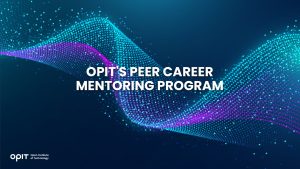
The Open Institute of Technology (OPIT) is the perfect place for those looking to master the core skills and gain the fundamental knowledge they need to enter the exciting and dynamic environment of the tech industry. While OPIT’s various degrees and courses unlock the doors to numerous careers, students may not know exactly which line of work they wish to enter, or how, exactly, to take the next steps.
That’s why, as well as providing exceptional online education in fields like Responsible AI, Computer Science, and Digital Business, OPIT also offers an array of career-related services, like the Peer Career Mentoring Program. Designed to provide the expert advice and support students need, this program helps students and alumni gain inspiration and insight to map out their future careers.
Introducing the OPIT Peer Career Mentoring Program
As the name implies, OPIT’s Peer Career Mentoring Program is about connecting students and alumni with experienced peers to provide insights, guidance, and mentorship and support their next steps on both a personal and professional level.
It provides a highly supportive and empowering space in which current and former learners can receive career-related advice and guidance, harnessing the rich and varied experiences of the OPIT community to accelerate growth and development.
Meet the Mentors
Plenty of experienced, expert mentors have already signed up to play their part in the Peer Career Mentoring Program at OPIT. They include managers, analysts, researchers, and more, all ready and eager to share the benefits of their experience and their unique perspectives on the tech industry, careers in tech, and the educational experience at OPIT.
Examples include:
- Marco Lorenzi: Having graduated from the MSc in Applied Data Science and AI program at OPIT, Marco has since progressed to a role as a Prompt Engineer at RWS Group and is passionate about supporting younger learners as they take their first steps into the workforce or seek career evolution.
- Antonio Amendolagine: Antonio graduated from the OPIT MSc in Applied Data Science and AI and currently works as a Product Marketing and CRM Manager with MER MEC SpA, focusing on international B2B businesses. Like other mentors in the program, he enjoys helping students feel more confident about achieving their future aims.
- Asya Mantovani: Asya took the MSc in Responsible AI program at OPIT before taking the next steps in her career as a Software Engineer with Accenture, one of the largest IT companies in the world, and a trusted partner of the institute. With a firm belief in knowledge-sharing and mutual support, she’s eager to help students progress and succeed.
The Value of the Peer Mentoring Program
The OPIT Peer Career Mentoring Program is an invaluable source of support, inspiration, motivation, and guidance for the many students and graduates of OPIT who feel the need for a helping hand or guiding light to help them find the way or make the right decisions moving forward. It’s a program built around the sharing of wisdom, skills, and insights, designed to empower all who take part.
Every student is different. Some have very clear, fixed, and firm objectives in mind for their futures. Others may have a slightly more vague outline of where they want to go and what they want to do. Others live more in the moment, focusing purely on the here and now, but not thinking too far ahead. All of these different types of people may need guidance and support from time to time, and peer mentoring provides that.
This program is also just one of many ways in which OPIT bridges the gaps between learners around the world, creating a whole community of students and educators, linked together by their shared passions for technology and development. So, even though you may study remotely at OPIT, you never need to feel alone or isolated from your peers.
Additional Career Services Offered by OPIT
The Peer Career Mentoring Program is just one part of the larger array of career services that students enjoy at the Open Institute of Technology.
- Career Coaching and Support: Students can schedule one-to-one sessions with the institute’s experts to receive insightful feedback, flexibly customized to their exact needs and situation. They can request resume audits, hone their interview skills, and develop action plans for the future, all with the help of experienced, expert coaches.
- Resource Hub: Maybe you need help differentiating between various career paths, or seeing where your degree might take you. Or you need a bit of assistance in handling the challenges of the job-hunting process. Either way, the OPIT Resource Hub contains the in-depth guides you need to get ahead and gain practical skills to confidently move forward.
- Career Events: Regularly, OPIT hosts online career event sessions with industry experts and leaders as guest speakers about the topics that most interest today’s tech students and graduates. You can join workshops to sharpen your skills and become a better prospect in the job market, or just listen to the lessons and insights of the pros.
- Internship Opportunities: There are few better ways to begin your professional journey than an internship at a top-tier company. OPIT unlocks the doors to numerous internship roles with trusted institute partners, as well as additional professional and project opportunities where you can get hands-on work experience at a high level.
In addition to the above, OPIT also teams up with an array of leading organizations around the world, including some of the biggest names, including AWS, Accenture, and Hype. Through this network of trust, OPIT facilitates students’ steps into the world of work.
Start Your Study Journey Today
As well as the Peer Career Mentoring Program, OPIT provides numerous other exciting advantages for those who enroll, including progressive assessments, round-the-clock support, affordable rates, and a team of international professors from top universities with real-world experience in technology. In short, it’s the perfect place to push forward and get the knowledge you need to succeed.
So, if you’re eager to become a tech leader of tomorrow, learn more about OPIT today.
Have questions?
Visit our FAQ page or get in touch with us!
Write us at +39 335 576 0263
Get in touch at hello@opit.com
Talk to one of our Study Advisors
We are international
We can speak in:

